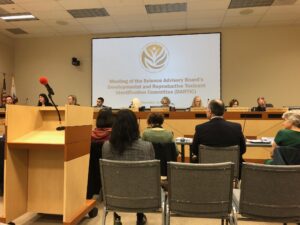UPDATE: OEHHA Issues Notice of Modifications to Cannabis Smoke and Delta-9-THC Exposure Warnings
The CA Office of Environmental Health Hazard Assessment (OEHHA) has proposed changes to the labeling of cannabis products and signage at venues where cannabis is smoked, vaped or dabbed following its ruling (opposed by CA NORML) that cannabis smoke and THC are reproductive toxins. Comments regarding the proposed changes to the text of regulations will be accepted by OEHHA through October 8, 2021 at https://oehha.ca.gov/comments.
December 12, 2019 – The Developmental and Reproductive Toxicant Identification Committee of the California Office of Environmental Health Hazard Assessment (OEHHA; a branch of Cal EPA) voted at a hearing on Wednesday to classify both cannabis smoke and delta-9-THC as reproductive toxins under California’s Prop. 65 law, over objections from Cal NORML.
Labeling requirements will take effect in one year; in the meantime the agency can issue warning language. Cannabis smoke has been declared to be cancer-causing under Prop. 65, also over the objections of Cal NORML.
Wednesday’s hearing began with Carol Moynahan Cummings, Chief Counsel advising the committee that their decisions must be made on scientific principles and not whether or not a warning might be required. They were to make a scientific judgement call and not a legal standard of proof, and they could base their call on animal evidence only.
Several staff members then gave reports on human and animal studies on outcomes including birth weight; viability and mortality; neurodevelopment; cognitive function; bone growth; and epigenetic effects. Their 400-page written report is at: https://oehha.ca.gov/media/downloads/crnr/cannabisdarthid100419.pdf
After the staff presentation, committee member Tracy Woodruff of UCSF criticized the report and the way it was organized and presented, including a paucity of information about why studies were included, or excluded. She noted that staff had started with some 400 studies, included 142 and excluded 74, leaving 219 not accounted for. Committee member Laurence Baskin said, “At every one of these meetings we’re presented with a lot of studies that are worthless.”
The meeting then moved to assigned “discussants” from the committee taking on each of the topics. Committee members were mostly unconvinced by human studies on developmental effects of cannabis smoking; however they were better convinced by animal studies on cannabis smoke or THC, particularly studies on bone growth. Human studies on epigenetic effects that suggested a mode of action were also thought to be convincing of toxicity.
The committee members found many faults with the human studies, including small numbers of subjects and a variety of different methods used, making the studies difficult to compare. Very few studies looked at a dose response, said committee member Carrie Breton of USC, although “studies are starting to get better on dose.” On pre-term birth, Dr. Breton said only 6 of 19 human studies found and association, and 4 out of 6 that looked at dose response did. Overall the evidence was “too thin” to draw conclusions. On birth defects, “the literature is really quite thin,” Breton said.
In rodent studies, dosages as high as 150-600 mg/kg/day were used, and in a Rhesus monkey study from Hendry et al. from the California Primate Resource Center, 250 mg/kg THC was used. Cal NORML estimates an adult daily dose of THC at 0.4 mg/kg. Still, the study found it was unclear whether or not THC has any effect on developmental toxicity.
Committee chair Ulricke Luderer, of UC Irvine chair, said that she agreed about the limitations of the studies, but said that studies on the immune system and bone development looked at more specific endpoints and made mechanistic observations, in terms of what we know about cannabinoid receptors and bone development. She cited a 2015 Wasserman study looking at post- and not pre-natal exposure, but still considered it a developmental study. “The weight of evidence supports developmental toxicity in animals,” she said.
Dr. Irva Hertz-Picciotto of UC Davis discussed neurodevelopmental epidemiological studies in humans, and found “very few studies actually use correct epidemiological methods.” Major issues are co-exposures and “how do you disentangle cannabis use from tobacco, cocaine, alcohol,” she said. Some studies were mainly looking at cocaine and another had few mothers who were not also using tobacco. Few looked at whether or not removing confounder changed statistical significance, and only some did mediation analysis. Was outcome at age 14 mediated by child depression, etc? she wondered. That could be the total effect. Only the Pittsburgh study from McGee Women’s Hospital had some control for maternal mental health status. In general study subjects were high risk, low-income, African American. It’s a mixed literature, she concluded, strongest in cognition, attention, and psychiatric issues by mid-late childhood and adolescence.
Dr. Hertz-Picciotto also criticized the use of the Brazelton neonatal assessment scale, saying if it had any validity it might be at 30 days. She brought up the 1994 Jamaican “ganga” study which she [wrongly] said found no association between infant development and marijuana use by mothers. In the five minutes of public comment she was allowed, Cal NORML deputy director Ellen Komp, corrected Dr. Hertz-Picciotto, pointing out that month-old babies born to marijuana-using mothers in the Jamaican study scored significantly higher on the Brazelton scale than did babies born to non-using mothers. A follow-up study showed no negative impacts on children, but no further follow-up studies could win approval from NIDA.
Komp asked the committee to take a hard look at the dosages used in the animal studies, which were often hundreds or thousands of times higher than the adult human dose. Dr. Hertz-Picciotto asked Dr. Woodruff about this; she replied that she thought some of the studies made an effort to correlate dosage to human doses. Chief Counsel Moynahan Cummings said the committee could decide that a substance belonged on the Prop. 65 list no matter what dosages were used in studies.
Committee members were concerned about the increased potency of cannabis. Komp tried to say that higher potency simply meant people smoked less cannabis, which was arguably healthier (but since her five-minute comment period was over, she was told to shut up). The committee was confused about whether fetuses have more CB1 and CB2 receptors than do adults; at one point Dr. Woodruff opined that since fetal brains have more lipids they might be more affected by THC, which is lipophilic.
The committee voted 9-0 to include cannabis smoke on the Prop. 65 list of reproductive toxicants, partly because it contained other toxic chemicals. Only Dr. Aydin Nazmi of Cal Poly voted against also adding THC to the Prop. 65 list.
Other points made by Cal NORML:
-The 2017 National Academy of Sciences review of existing evidence on cannabis use concluded that, “Smoking cannabis during pregnancy is linked to lower birth weight in the offspring. The relationship between smoking cannabis during pregnancy and other pregnancy and childhood outcomes is unclear.”
-A 2018 population-based study (Ko), which was also excluded from the staff report, found, ” [M]arijuana use during pregnancy was not independently associated with infant birth weight or gestational age, after controlling for confounding factors … Further, we did not observe significant effects of marijuana use during pregnancy and preterm birth or healthcare utilization.”
– Bottles of Marinol, and FDA-approved oral THC medication, do not say that cannabis is a reproductive toxin; they cite three different rodent studies that found no developmental effect despite using doses much higher than human ones.
-In any case, Prop. 65 warnings are unnecessary because warnings are already required by current Department of Public Health regulations. All licensed cannabis products in California, whether intended to be smoked, vaporized, or taken orally, are currently labeled, “Cannabis use while pregnant or breastfeeding may be harmful.”
These CDPH warnings are similar to the Surgeon General warnings on packages of cigarettes or alcohol, which do not contain extra and potentially repetitive or confusing Prop. 65 warnings.
Cal NORML director Dale Gieringer pointed out that Prop 65 specifies that a chemical shall be considered to cause reproductive toxicity if it ” has been clearly shown through scientifically valid testing” to do so. There is nothing clear about the current evidence. Unfortunately, OEHHA has taken the position that human studies aren’t determinative and that dosage doesn’t matter – no matter how minute the exposure, if a chemical has been shown to be toxic at some level, it must be listed regardless of whether it is far below the threshold where human harm might be expected.

